Top 5 Must-Try Dishes in Kerala Cuisine in 2024
Introduction to Authentic Kerala Cuisine
Kerala, often celebrated as “God’s Own Country,” boasts a culinary heritage as vibrant and diverse as its picturesque landscapes. Nestled in the southwestern coast of India, Kerala’s cuisine is a harmonious blend of spices, fresh seafood, and an array of tropical fruits and vegetables. Rooted in centuries-old traditions, Kerala cuisine reflects the state’s rich cultural tapestry, influenced by various communities and historical trade links. From the festive Ambalapuzha Palpayasam to the fiery Kerala Beef Roast, each dish offers a unique taste experience that embodies the essence of Kerala.
What You Will Discover in this Blog:
- Ambalapuzha Palpayasam Recipe Variations
- Kerala Halwa – The Sweetness of Tradition
- Kootu Curry and Other Kerala Sadya Staples
- Kerala Beef Dishes to Spice Up Your Meal
- Kerala Potato Curry – Traditional Flavors
Let’s embark on a culinary journey through Kerala’s most beloved dishes!
1. Ambalapuzha Palpayasam Recipe Variations
Ambalapuzha Palpayasam is a quintessential Kerala dessert, revered for its simplicity and divine taste. Originating from the Ambalapuzha Sri Krishna Temple, this sweet pudding is traditionally offered to devotees, symbolizing devotion and celebration.
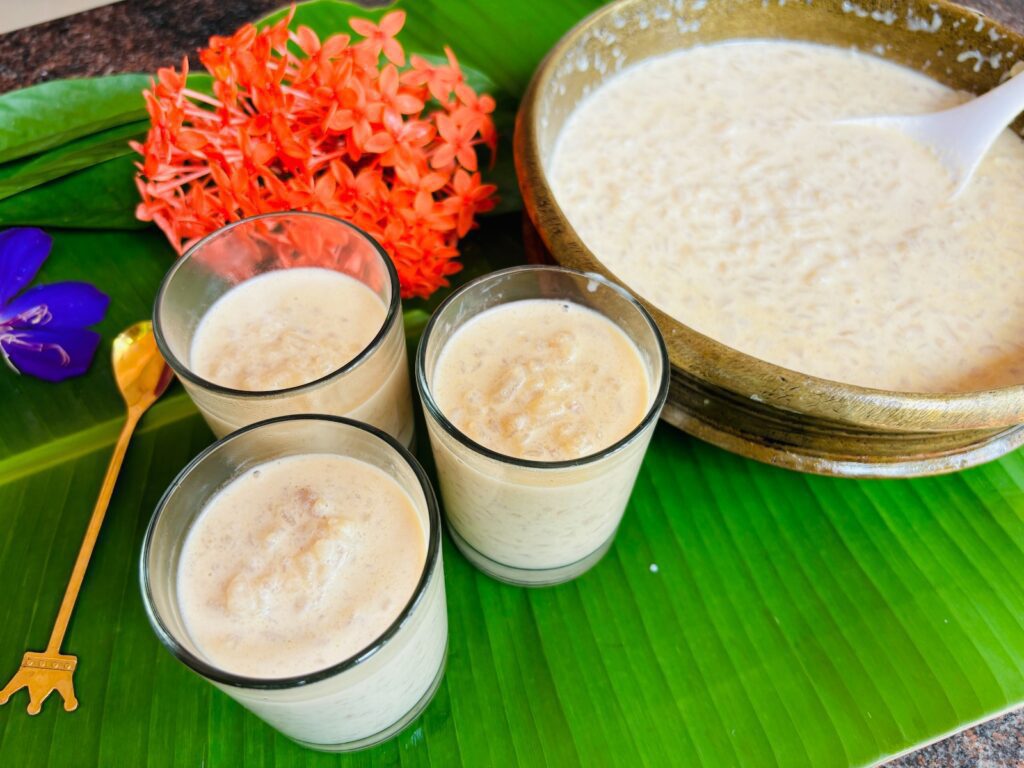
Traditional Recipe
The authentic Ambalapuzha Palpayasam is crafted using parboiled rice, thickened milk, and jaggery. The slow-cooking process allows the flavors to meld, resulting in a rich, caramelized taste that is both comforting and indulgent.
Popular Payasam Varieties:
- Kerala Semiya Payasam: Made with vermicelli, this variant is lighter and often flavored with cardamom and garnished with fried nuts.
- Nei Payasam: A decadent version enriched with ghee (clarified butter), jaggery, and rice, offering a deeper, richer flavor profile.
- Ari Payasam: A rice-based payasam typically served in temples, known for its smooth texture and subtle sweetness.
- Temple Payasam: Similar to Ari Payasam but often includes a blend of different grains and spices, enhancing its complexity.
- Sweet Potato Payasam: Incorporates sweet potatoes, adding an earthy sweetness and unique texture.
- Dates And Badam Payasam: Enriched with dates and almonds, this version provides a chewy texture and nutty flavor.
- Ragi Green Gram Payasam: A healthier alternative using ragi (finger millet) and green gram, offering added nutrients and a distinct taste.
- Chakka Payasam: Features jackfruit, infusing the payasam with a tropical twist.
- Rice Payasam: The classic rice pudding variant, beloved across Kerala for its straightforward yet satisfying flavor.
- Kerala Paal Payasam: The quintessential milk-based payasam, emphasizing the purity of milk and jaggery.
- Pineapple Payasam: Incorporates pineapple, lending a tangy and sweet flavor that’s refreshingly different.
- Khus Khus Payasam: Made with poppy seeds, adding a subtle nuttiness and unique texture.
- Malabar Persian Payasam: A Malabar specialty with Persian influences, often featuring exotic spices and ingredients.
- Broken Wheat Payasam: A traditional Kerala dessert made with cracked wheat, coconut milk, and jaggery, commonly enjoyed during Onam feasts.
- Unakkalari Payasam: A rich, creamy payasam made with Kerala’s unakkalari (red rice), coconut milk, and jaggery, often prepared for Onam celebrations.
- Cherupayar Parippu Payasam: A festive payasam made with split green gram, jaggery, and coconut milk, popular in Kerala’s Onam Sadya.
Expert Tips:
- Quality Ingredients: Use fresh, high-quality ingredients like pure jaggery and thickened milk to enhance the flavor.
- Slow Cooking: Allow the payasam to simmer slowly to achieve the perfect consistency and depth of flavor.
- Garnishing: Enhance the presentation and taste by garnishing with fried nuts, raisins, or a sprinkle of cardamom.
Health Benefits:
Payasam is not just a treat for the taste buds but also offers several health benefits. Ingredients like jaggery provide energy, while nuts and seeds add essential nutrients and healthy fats.
2. Kerala Halwa – The Sweetness of Tradition
Kerala Halwa is a beloved sweet treat that holds a special place in the hearts of Keralites. Known for its chewy texture and rich flavor, Halwa is a staple during festivals and celebrations.
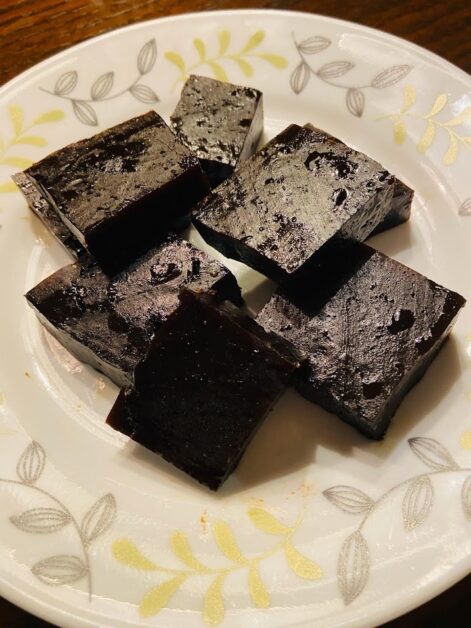

Kerala Black Halwa
The signature Black Halwa is distinguished by its deep, dark color, achieved by using generous amounts of jaggery. Made with rice flour, coconut milk, and ghee, this halwa is cooked slowly, requiring constant stirring to prevent burning and to achieve its glossy finish.
Popular Varieties of Kerala Halwa:
- Kerala Black Halwa : The traditional, richly flavored halwa with a chewy texture.
- Banana Halwa: Made from ripe bananas and coconut, offering a fruity sweetness.
- Kerala Mixed Fruit Halwa: Combines various fruits, creating a burst of flavors in every bite.
- Papaya Halwa: Features fresh papaya, providing a tropical twist.
- Red Halwa: Uses white sugar instead of jaggery, resulting in a lighter color and milder sweetness.
- Wheat Halwa: Crafted with wheat flour and ghee, delivering a smooth and nutty flavor.
- Arrowroot Halwa (Koova Vilayicha Halwa): Utilizes arrowroot for a lighter texture.
- Carrot Halwa: Incorporates grated carrots, adding natural sweetness and vibrant color.
- Jackfruit Halwa: Infused with the natural sweetness of ripe jackfruit.
- Coconut Halwa: Emphasizes coconut, providing a rich and creamy texture.
- Cashew Nut Halwa: Enriched with cashews, offering a crunchy texture and nutty flavor.
- Sooji Halwa: Made with semolina, giving it a grainy texture and delicate taste.
- Rava Halwa: Similar to Sooji Halwa but with a finer texture.
- Caramel Halwa: Features caramelized sugar for a deep, rich flavor.
- Gothambu Halwa: Made with wheat flour and sugar, often garnished with nuts.
- Condensed Milk Halwa: Uses condensed milk for extra sweetness and creaminess.
Expert Insights:
- Consistency is Key: Achieving the right consistency is crucial. The halwa should be neither too runny nor too dry.
- Flavor Enhancements: Adding a hint of cardamom or saffron can elevate the flavor profile.
- Storage: Halwa can be stored for several days, making it a convenient option for festive occasions.
Cultural Significance:
Halwa is more than just a dessert in Kerala; it’s a symbol of hospitality and celebration. It’s often prepared during weddings, festivals like Onam, and other significant events, bringing families and communities together.
3. Kootu Curry and Other Kerala Sadya Staples
A traditional Sadya, the grand feast served during festivals like Onam and Vishu, is incomplete without an array of flavorful dishes. Among these, Kootu Curry stands out as a hearty and nutritious dish that balances the meal with its mild yet rich flavors.
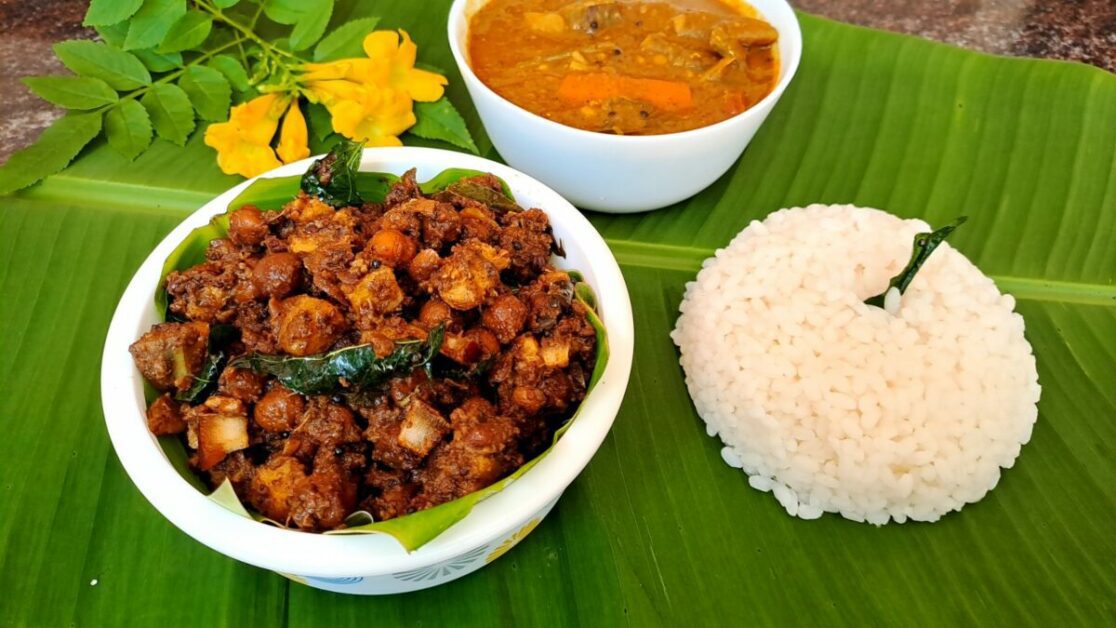

Kootu Curry
Kootu Curry is a vegetable and lentil stew cooked in a coconut-based gravy. It’s both comforting and flavorful, making it a favorite during festive meals.
Popular Kootu Curry Varieties:
- Kerala Style Koottu Curry: The traditional Sadya version featuring a mix of root vegetables and black chickpeas.
- Kootu Kari: A simpler version using a single type of vegetable in a coconut gravy.
- Sadya Special Kootu Curry: Enhanced with a variety of spices and vegetables, perfect for festive occasions.
- Kadala And Chena Kootu Curry: Combines chickpeas (kadala) and yam (chena) for a hearty dish.
- Pollachi Spinach (Keerai) Kootu: Incorporates spinach, adding a nutritious green element.
- Vallarai Kootu (Brahmi Leaves): Uses Brahmi leaves, known for their medicinal properties.
- Pudina Ela Thaiyru Kootu: A mint-flavored, yogurt-based variant that offers a refreshing taste.
- Vazhaipoo Koottu (Plantain Flower Kootu): Made with banana flowers, rich in nutrients and unique in flavor.
- Milagu Kootu: A pepper-based version that adds a spicy kick.
- Moong Dal Pudalangai Kootu: Features moong dal and snake gourd, offering a light and healthy option.
Other Sadya Staples:
- Avial: A mixed vegetable dish cooked in a yogurt and coconut base, seasoned with coconut oil and curry leaves.
- Thoran: Stir-fried vegetables, typically with grated coconut, providing a crunchy texture.
- Olan: A mild curry made from ash gourd and cowpeas in a coconut milk base, offering a light and soothing flavor.
Expert Tips:
- Balancing Flavors: Kootu Curry should balance the spiciness of other Sadya dishes with its mild, creamy texture.
- Fresh Ingredients: Use fresh, seasonal vegetables to enhance the taste and nutritional value.
- Coconut Preparation: Freshly grated coconut yields a better texture and flavor compared to desiccated varieties.
Health Benefits:
Kootu Curry is packed with vegetables and lentils, making it a nutrient-dense dish. It provides essential vitamins, minerals, and protein, contributing to a balanced and healthy meal.
4. Kerala Beef Dishes to Spice Up Your Meal
Kerala’s non-vegetarian cuisine is renowned for its bold flavors and aromatic spices, with beef dishes taking center stage. Whether you’re a spice enthusiast or looking to explore new flavors, Kerala beef recipes offer a tantalizing experience.
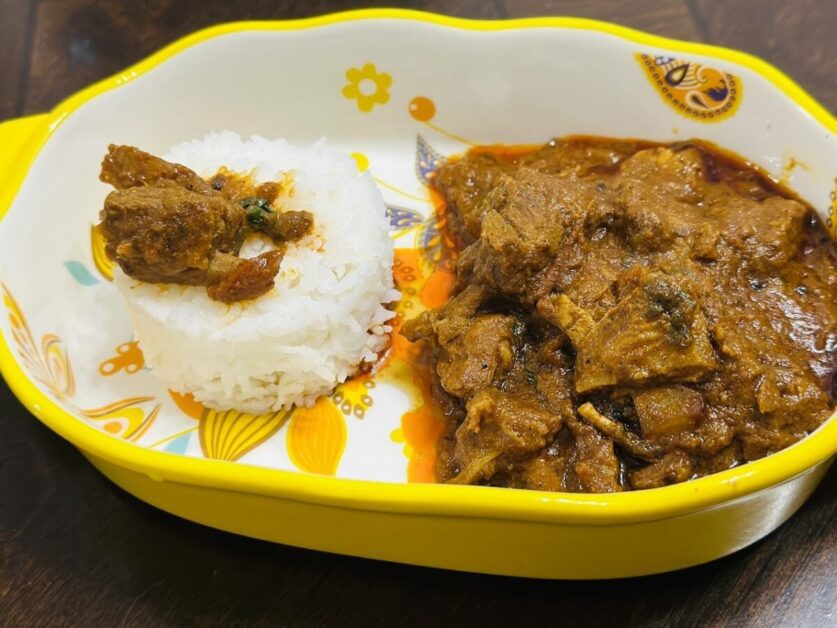

Kerala Beef Roast
The Kerala Beef Roast is a fiery and flavorful dish that highlights the region’s love for spices. Tender beef chunks are marinated in a blend of spices, slow-cooked to perfection, and then stir-fried to achieve a caramelized, spicy coating.
Popular Beef Varieties:
- Nadan Kerala Beef Fry: A rustic, home-style beef fry with a deep, rich flavor.
- Beef Roast Kerala Style: A spicier, roasted version that is often served as a main course.
- Chilly Beef (BDF) Palakkad Style: A Palakkad specialty with a distinctive crunchy texture.
- Beef Ularthiyathu: A slow-cooked beef dish infused with spices and coconut oil, resulting in tender meat.
- Kerala Beef Curry (Beef Masala): A rich, spiced curry that pairs well with rice or appams.
- Malabar Style Beef Roast: A deliciously spicy roast originating from the Malabar region.
- Kottayam Style Beef Fry (Beef Ularthiyathu): A stir-fried version with an abundance of spices.
- Beef Sukka: A semi-dry beef dish cooked with grated coconut, enhancing its texture and flavor.
- Beef Pepper Fry: Spicy beef fry with a pronounced peppery kick.
- Beef Tikka Masala: An Indo-fusion dish combining Kerala spices with the classic tikka masala.
- Malappuram Beef Varattiyathu: A dry beef roast from Malappuram, known for its robust flavor.
Kerala Beef Roast Recipe (Example)
Ingredients:
- 500g beef, cut into chunks
- 2 onions, finely sliced
- 2 tomatoes, chopped
- 3 tablespoons coconut oil
- 2 teaspoons ginger-garlic paste
- 1 tablespoon red chili powder
- 1 teaspoon coriander powder
- 1 teaspoon black pepper powder
- 1 teaspoon garam masala
- Salt to taste
- Curry leaves for garnish
Instructions:
- Marination: Marinate the beef with ginger-garlic paste, red chili powder, coriander powder, black pepper, and salt. Let it sit for at least 1 hour.
- Cooking: Heat coconut oil in a pan. Add sliced onions and sauté until golden brown. Add chopped tomatoes and cook until they soften.
- Adding Beef: Add the marinated beef and cook on medium heat until the meat is tender. This may take about 30-40 minutes.
- Roasting: Once the beef is tender, increase the heat and stir-fry until the oil separates and the beef is caramelized.
- Finishing Touch: Sprinkle garam masala and garnish with curry leaves. Serve hot with rice or bread.
Expert Insights:
- Marination Time: Allowing ample time for marination ensures the beef absorbs the spices, enhancing its flavor.
- Cooking Method: Slow-cooking is essential for tender meat; high heat can make the beef tough.
- Garnishing: Fresh curry leaves not only add aroma but also elevate the visual appeal of the dish.
Cultural Significance:
Beef dishes are integral to Kerala’s culinary landscape, especially among the Christian and Muslim communities. They are often featured in festive meals, special occasions, and everyday family dinners, showcasing the state’s culinary diversity.
5. Kerala Potato Curry – Traditional Flavors
While Kerala is famed for its seafood and meat dishes, Potato Curry holds its own as a versatile and beloved dish. It’s a staple in many households, offering comfort and flexibility in its preparation.
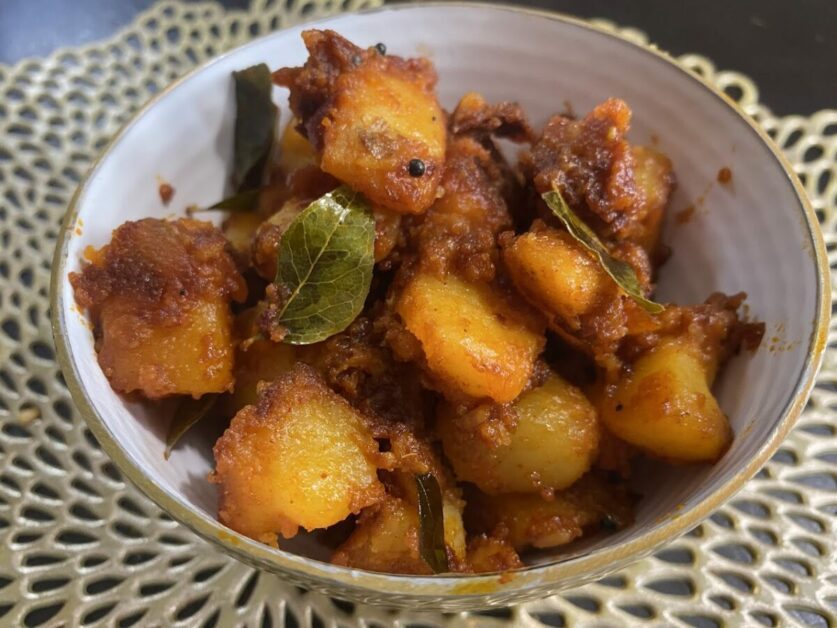

Kerala Potato Curry
Kerala Potato Curry is a simple yet flavorful dish that highlights the humble potato’s versatility. It can be prepared in various ways, accommodating both coconut-based and coconut-free preferences.
Popular Potato Curry Varieties:
- Kerala Easy Potato Curry: A straightforward recipe perfect for everyday meals.
- Kerala Style Potato Curry: Traditional preparation with authentic spices.
- Kerala Style Potato Curry With Coconut Milk: Adds richness and a creamy texture using coconut milk.
- Kerala Easy Potato Stew: A milder version, often served with appams or idiyappam.
- Easy Potato Masala Curry: Quick and flavorful, ideal for busy days.
- Special Potato Curry Easy: Enhanced with additional spices and ingredients for a special touch.
- Potato Roast: A dry, roasted version with a crispy texture.
- Potato Masala: A spiced potato dish that pairs well with rice or bread.
- Field Beans Potato Curry: Combines field beans and potatoes for a nutritious meal.
- Potato Masala Curry – Perfect Side Dish: A versatile side that complements various main courses.
- Easy Potato Kurma: A curry-like dish with a blend of spices and sometimes coconut.
Additional Varieties to Include:
- Special Potato Curry Easy: An enhanced version with added spices and ingredients.
- Potato Roast: A dry, roasted version that is crispy and flavorful.
- Field Beans Potato Curry: Combines field beans and potatoes, adding nutritional value.
- Easy Potato Kurma: A spiced curry with a rich, aromatic flavor profile.
Kerala Potato Curry Recipe (Example)
Ingredients:
- 4 medium potatoes, peeled and cubed
- 2 onions, finely chopped
- 2 tomatoes, chopped
- 2 green chilies, slit
- 1 teaspoon mustard seeds
- 1 teaspoon cumin seeds
- 2 tablespoons coconut oil
- 1 teaspoon turmeric powder
- 1 teaspoon red chili powder
- 1 teaspoon coriander powder
- Salt to taste
- Curry leaves for garnish
Instructions:
- Tempering: Heat coconut oil in a pan. Add mustard seeds and let them splutter. Add cumin seeds, green chilies, and curry leaves.
- Sautéing: Add chopped onions and sauté until golden brown. Add tomatoes and cook until they soften.
- Spicing: Mix in turmeric powder, red chili powder, coriander powder, and salt. Cook the spices for a few minutes until fragrant.
- Adding Potatoes: Add the cubed potatoes and stir to coat them with the spice mixture.
- Cooking: Add enough water to cover the potatoes. Cover and cook on medium heat until the potatoes are tender.
- Final Touch: Garnish with fresh curry leaves and serve hot with rice, chapatis, or appams.
Expert Tips:
- Uniform Potato Pieces: Cutting potatoes into uniform pieces ensures even cooking.
- Spice Levels: Adjust the number of green chilies and red chili powder according to your spice preference.
- Consistency: For a thicker curry, reduce the water quantity; for a more gravy-like consistency, add more water or coconut milk.
Health Benefits:
Potato Curry is not only delicious but also provides essential nutrients like carbohydrates, vitamins C and B6, and potassium. When combined with vegetables like field beans, it becomes a balanced and nutritious meal.
Why Kerala Cuisine Stands Out:
- Diverse Ingredients: The use of coconut in various forms—oil, milk, grated—adds a distinctive flavor and richness to the dishes.
- Aromatic Spices: Spices like black pepper, mustard seeds, and curry leaves infuse the food with deep, layered flavors.
- Cultural Fusion: Influences from various communities and historical trade links have enriched Kerala’s culinary landscape, making it both traditional and innovative.
- Nutrient-Rich: Kerala dishes often incorporate a balance of proteins, carbohydrates, and healthy fats, ensuring meals are both tasty and nutritious.
Conclusion: Experience the True Flavors of Kerala
Kerala’s cuisine is a testament to its rich cultural heritage and diverse natural resources. From the sweet and creamy Ambalapuzha Palpayasam to the robust and spicy Kerala Beef Roast, each dish offers a unique glimpse into the state’s culinary traditions. The myriad of Kerala Halwa varieties showcases the region’s love for sweets, while Kootu Curry and other Sadya staples reflect the communal and celebratory spirit of Kerala. Whether you’re indulging in a festive feast or enjoying a simple meal at home, the flavors of Kerala promise a delightful and memorable culinary experience.

